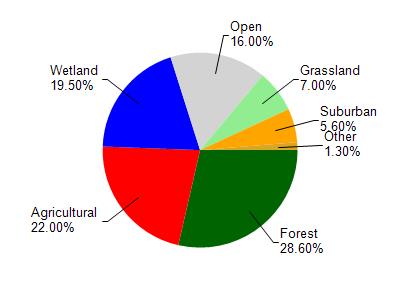Menominee
No
No
No
Fish and Aquatic Life
Overview
Little Rice Lake is a medium hard water drainage lake having alkaline, clear water of low transparency. Littoral material consists of muck. Lake is bordered by a sedge mat-bag wetland shading into an upland of oak with some white birch, aspen and pine. Tamarack wetland drainage from Pine Lake is located on the north shore. Outlet stream flows to Loon Creek. Navigable inlet from lake 36-7 (r-28-N, R-16-E) enters on the east shore. Northern pike, largemouth bass and pan fish comprise the fish population. Protection of the marsh areas bordering the Inlet and outlet streams is essential in order to maintain suitable spawning areas for northern pike. Shallowness suggests that winterkill conditions may prevail, but apparently the incoming flow of water is sufficient to maintain suitable oxygen levels. No developments are located on the shore line. Tertiary company road adjoins lake. Moderate utilization by waterfowl occurs during the fall migration.
Source: 1963, Surface Water Resources of Menominee County Rice Lake - T-28-N, R-16-E, Section 35 Surface Area = 38.4 acres, S.D.F. = 1.85, Maximum Depth = 4 feet.
Date 1963
Author Aquatic Biologist
Condition
Wisconsin has over 84,000 miles of streams, 15,000 lakes and milllions of acres of wetlands. Assessing the condition of this vast amount of water is challenging. The state's water monitoring program uses a media-based, cross-program approach to analyze water condition. An updated monitoring strategy (2015-2020) is now available. Compliance with Clean Water Act fishable, swimmable standards are located in the Executive Summary of Water Condition in 2018. See also the 'monitoring and projects' tab.
Management Goals
Wisconsin's Water Quality Standards provide qualitative and quantitative goals for waters that are protective of Fishable, Swimmable conditions [Learn more]. Waters that do not meet water quality standards are considered impaired and restoration actions are planned and carried out until the water is once again fishable and swimmable
Management goals can include creation or implementation of a Total Maximum Daily Load analysis, a Nine Key Element Plan, or other restoration work, education and outreach and more. If specific recommendations exist for this water, they will be displayed below online.
Monitoring
Monitoring the condition of a river, stream, or lake includes gathering physical, chemical, biological, and habitat data. Comprehensive studies often gather all these parameters in great detail, while lighter assessment events will involve sampling physical, chemical and biological data such as macroinvertebrates. Aquatic macroinvertebrates and fish communities integrate watershed or catchment condition, providing great insight into overall ecosystem health. Chemical and habitat parameters tell researchers more about human induced problems including contaminated runoff, point source dischargers, or habitat issues that foster or limit the potential of aquatic communities to thrive in a given area. Wisconsin's Water Monitoring Strategy was recenty updated.
Grants and Management Projects
| Project Name (Click for Details) | Year Started |
|---|
|
|
Monitoring Projects
| WBIC | Official Waterbody Name | Station ID | Station Name | Earliest Fieldwork Date | Latest Fieldwork Date | View Station | View Data |
|---|
| 324300 | Rice Lake | 10003972 | Rice Lake | 7/27/1999 | 10/3/2012 | Map | Data |
|

Watershed Characteristics
Rice Lake is located in the Shawano Lake watershed which is 71.16 mi². Land use in the watershed is primarily forest (28.60%), agricultural (22%) and a mix of wetland (19.50%) and other uses (29.90%). This watershed has 76.28 stream miles, 7,438.74 lake acres and 7,573.91 wetland acres.
Nonpoint Source Characteristics
This watershed is ranked Not Ranked for runoff impacts on streams, High for runoff impacts on lakes and High for runoff impacts on groundwater and therefore has an overall rank of High. This value can be used in ranking the watershed or individual waterbodies for grant funding under state and county programs.However, all waters are affected by diffuse pollutant sources regardless of initial water quality. Applications for specific runoff projects under state or county grant programs may be pursued. For more information, go to surface water program grants.